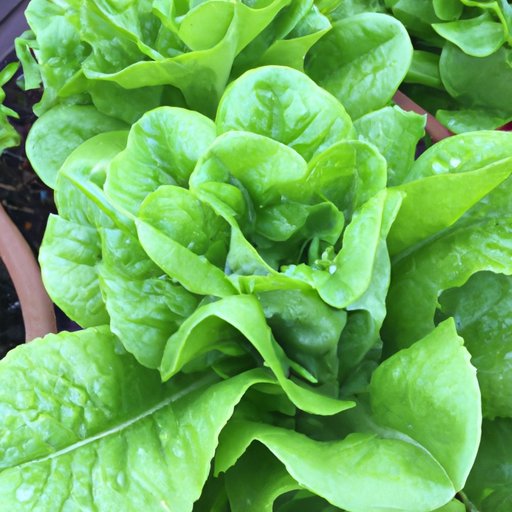
Introduction
Are you interested in growing your own lettuce but unsure where to begin? You’re not alone! Growing lettuce can be a rewarding experience, but it requires a bit of knowledge and effort. This article is intended for beginners who want to learn how to grow lettuce successfully. We’ll cover everything from preparing the soil to harvesting your crop. By following our step-by-step guide and helpful tips, you’ll be enjoying fresh, homegrown lettuce in no time.
Step-by-Step Guide
The following steps will guide you through the process of growing lettuce:
1. Prepare the Soil
Lettuce prefers well-draining soil that is rich in organic matter. Start by removing any weeds from your garden bed and loosening the soil with a garden fork or tiller. If your soil is heavy, add some compost or other organic matter to improve its texture.
2. Plant the Seeds
Lettuce seeds can be sown directly into the soil or started indoors and transplanted later. If sowing directly, sprinkle the seeds thinly and cover them with a light layer of soil. Water gently and keep the soil consistently moist. If starting indoors, plant the seeds in seed-starting trays or pots, and keep them under grow lights or in a sunny window until they are ready to be transplanted outdoors.
3. Water and Fertilize
Lettuce needs plenty of water, especially during hot and dry weather. Keep the soil consistently moist, but not waterlogged. You can also mulch around the plants to help retain moisture. Fertilize your lettuce plants every few weeks with a balanced fertilizer, or apply a slow-release fertilizer at the beginning of the growing season.
4. Harvest
Harvest your lettuce when the leaves are mature but still tender. You can either pick individual leaves as you need them, or cut the whole head at once. Lettuce can be eaten fresh, added to salads or sandwiches, or used as a garnish.

Seasonal Growing
The best time to plant lettuce depends on the climate and conditions in your area. Lettuce is a cool-season crop that prefers temperatures between 45-75°F. In most regions, lettuce can be planted in early spring or fall for the best results. In warmer climates, it can be grown in the winter months. Different lettuce varieties have different growing requirements. For example, butterhead lettuce prefers cooler temperatures and can be grown in partial shade, while romaine lettuce prefers full sun and can tolerate heat better.
Container Growing
If you don’t have space for a garden bed, you can still grow lettuce in pots or other containers. Choose a container that is at least 6-8 inches deep and has drainage holes at the bottom. Fill it with well-draining soil and sow the seeds or transplant seedlings. Keep the soil consistently moist and fertilize regularly. The benefit of container growing is that you can easily move your lettuce plants to a sunnier or shadier spot as needed, and you can also protect them from pests and diseases easier.
Companion Planting
Companion planting is the practice of planting different crops together for mutual benefits. Lettuce can grow well when planted near certain other plants, such as carrots, onions, or radishes. These plants can help repel pests and provide shade, while lettuce can help keep the soil cool and moist. Companion planting can also improve the flavor and health of both crops. Avoid planting lettuce near herbs or vegetables in the same family, such as dill or fennel, as they can harm the growth of lettuce.
Troubleshooting Tips
Like any crop, lettuce can face various issues, such as pests, disease, or soil nutrient deficiencies. Here are some tips to help you deal with these problems:
Pests
- Use row covers to keep pests away from young plants
- Handpick caterpillars, slugs, or other visible insects
- Spray plants with insecticidal soap or neem oil
Disease
- Avoid overcrowding and improve air circulation around plants
- Water plants at the base and avoid wetting the leaves
- Remove any infected plants and dispose of them properly
- Rotate your crops every year to prevent disease buildup in the soil
Soil Nutrient Deficiencies
- Add compost or other organic matter to improve soil fertility
- Fertilize plants with a balanced fertilizer, or apply specific nutrients, such as nitrogen or calcium, as needed
- Test your soil regularly to monitor nutrient levels
Conclusion
Congratulations, you’re now a lettuce-growing expert! We hope this guide has provided you with everything you need to know to grow your own lettuce successfully. Remember to start with healthy soil, choose the right lettuce varieties for your climate and growing conditions, and provide consistent water and nutrients to your plants. If you encounter any problems, don’t give up! Use our troubleshooting tips to overcome them. Finally, we encourage you to share your own tips and experiences with growing lettuce in the comments below.





